A Navigational Data Model for Object Modeling Technique (OMT) Development Environment
- 格式:pdf
- 大小:228.31 KB
- 文档页数:22
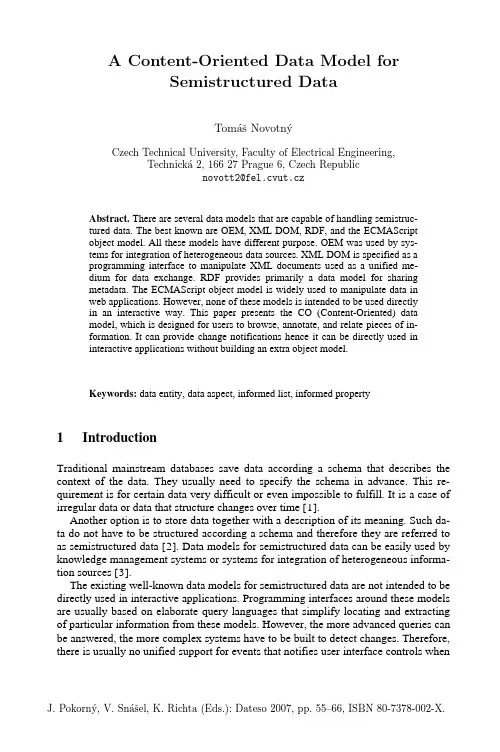
A Content-Oriented Data Model forSemistructured DataTom´a ˇs Novotn´yCzech Technical University,Faculty of Electrical Engineering,Technick´a 2,16627Prague 6,Czech Republic novott2@fel.cvut.czTomáš Novotný Czech Technical University, Faculty of Electrical Engineering Technická 2, 166 27 Prague 6, Czech Republic novott2@fel.cvut.cz Abstract. There are several data models that are capable of handling semistruc-tured data. The best known are OEM, XML DOM, RDF, and the ECMAScript object model. All these models have different purpose. OEM was used by sys-tems for integration of heterogeneous data sources. XML DOM is specified as a programming interface to manipulate XML documents used as a unified me-dium for data exchange. RDF provides primarily a data model for sharing metadata. The ECMAScript object model is widely used to manipulate data in web applications. However, none of these models is intended to be used directly in an interactive way. This paper presents the CO (Content-Oriented) data model, which is designed for users to browse, annotate, and relate pieces of in-formation. It can provide change notifications hence it can be directly used in interactive applications without building an extra object model.Keywords: data entity, data aspect, informed list, informed property1 IntroductionTraditional mainstream databases save data according a schema that describes the context of the data. They usually need to specify the schema in advance. This re-quirement is for certain data very difficult or even impossible to fulfill. It is a case of irregular data or data that structure changes over time [1].Another option is to store data together with a description of its meaning. Such da-ta do not have to be structured according a schema and therefore they are referred to as semistructured data [2]. Data models for semistructured data can be easily used by knowledge management systems or systems for integration of heterogeneous informa-tion sources [3].The existing well-known data models for semistructured data are not intended to be directly used in interactive applications. Programming interfaces around these models are usually based on elaborate query languages that simplify locating and extracting of particular information from these models. However, the more advanced queries can be answered, the more complex systems have to be built to detect changes. Therefore, there is usually no unified support for events that notifies user interface controls when J.Pokorn´y ,V.Sn´a ˇs el,K.Richta (Eds.):Dateso 2007,pp.55–66,ISBN 80-7378-002-X.56Tom´aˇs Novotn´ysomething has changed hence such data models cannot be directly used in interactive applications.This paper describes the CO data model that unlike other data models for semis-tructured data is intended for interactive applications, especially applications that al-low users to browse, annotate, and relate pieces of information. It can be also used for visual manipulation with data stored in other data models or exchange formats for semistructured data like XML or JSON. It is designed to be very simple in order to keep implementation simple.The CO data model has a modular architecture. A core provides very limited func-tionality enabling basic manipulation with data. The core itself is not intended for in-teractive applications as the change notifications are not supported. Nevertheless, it may be used by scripts that are using the same data model. Other features are pro-vided by external modules called extensions. This extensible architecture allows de-velopers to choose particular configuration that will support just required features without unwanted ones. It also enables having various implementations of the same feature in order to enable direct data binding for various user interface toolkits.Other data models for semistructured data and systems for that they were built are described in the second chapter. A design the CO data model and an implementation of a framework for the CO data model are presented in the third and fourth chapters. Conclusions and a future work are given in the last chapter.Work2 RelatedWith the development and growth of the Web [4] in the last decade of the last century there arose a need to extract and integrate data that are available on the Web [5]. At the same time, there was a research project called TSIMMIS whose aim was to create a system for assisted integration of data either structured (e.g. database records), semistructured (e.g. web pages), or unstructured (e.g. plain files) from heterogeneous data sources [6].2.1 TSIMMISTSIMMIS was a joint project between Stanford and the IBM Almaden Research Cen-ter [3]. It had mediator architecture [7] [8] and it basically consisted of four types of core components: translators, mediators, constraint managers, and classi-fier/extractors. Translators were template-based wrappers [9] that converted data from various sources into a common information model. Mediators were information routers that forward queries to particular translators and merge the results [10]. Con-straint managers [11] ensured that the integrated data are consistent. Classi-fier/extractors automatically classified and extracted key properties of resources from the unstructured data sources. They were based on the Rufus system developed by the Almaden Research Center [12].Information between these components was exchanged in a self-describing object model called OEM (Object Exchange Model) [13]. OEM allowed the storing of nested objects. Each object was represented by a structure with four fields: label, type,A Content-Oriented Data Model for Semistructured Data57 value, and oid. The label was a string tag that describes what the object represents. The type was a data type of the object’s value. The value stored the actual data. The oid was a unique identifier of the object.TSIMMIS was not a fully automated system, but rather a tool to assist humans. It provided a graphical user interface component called MOBIE (MOsaic Based Infor-mation Explorer) [14] that allowed users to browse OEM objects and specify queries in an SQL-like language called OEM-QL [13].2.2 LORELORE (Lightweight Object REpository) was a database management system designed to manage semistructured data [1]. It was built on top of the O2 object database [15]. Semistructured data were stored in a modified OEM that was presented in the TSIMMIS project. That version of OEM could be represented as a labeled directed graph where the vertices were objects. There were two types of objects: complex ob-jects and atomic objects. Whereas the complex objects might have outgoing edges to other objects, the atomic objects had no outgoing edges but they contained a value from one of the atomic types (e.g. integer or string).LORE provided a query language called LOREL [16]. LOREL was defined as an extension to OQL (an SQL-like query language for the ODMG model) [17]. LOREL was also later used as a query language for TSIMMIS [8].LORE introduced a DataGuide [18]. The DataGuide was a structure summary of the OEM model that was automatically maintained. DataGuides allowed users to browse the OEM model and formulate queries. They were also used by the system to store statistics and to optimize the queries. The DataGuide itself was an OEM object so it could be stored in and managed by an OEM DBMS.Another feature of LORE was an external data manager [19]. The external data manager allowed users to integrate data from external data sources. The external data were represented by an external object. The external object was stored in the OEM database and it contained both a specification on how to fetch the external data and a cached version of the external data. The wrappers for the external data were reused from the TSIMMIS project.After the emergence of XML, developers of LORE found that data models of XML and OEM were similar. So they decided to modify LORE to serve as a data manage-ment system for XML [20]. The modifications to LORE also required changes to the data model [21].2.3 XMLXML is a markup language designed for data exchange [22]. The data are represented as documents. The XML document is a tree-like structure built from nested tagged elements. Each element can contain data stored as attributes/value pairs or as a plain text. XML also provides a mechanism to create links between elements.There are several ways to extract information from XML documents. None of them can be considered as universal but each is convenient for a particular purpose. One of58Tom´aˇs Novotn´ythe best known is SAX. SAX (Simple API for XML) provides a read-only and for-ward-only event-driven interface [23]. Another read-only interface is XmlReader (not to be confused with XMLReader, the Java interface from the SAX2 library). In con-trast to SAX, XmlReader allows developers to navigate through XML on-demand in the way that is sometimes referred to as a pull model [24]. More sophisticated naviga-tion provides XPathNavigator that enables cursor-like navigation in a XML document powered by XPath expressions [25].There is also a standardized virtual data model for XML called DOM (Document Object Model) that is specified as a programming interface and it is developed to ma-nipulate a memory representation of XML documents [26].2.4 RDFRDF (Resource Description Framework) is a set of specifications [27] that was cre-ated to provide a unified way to share metadata and it can be also used to represent data [28]. Although RDF is more complex than previous models, the data model of RDF can be represented by a collection of triples [29]. Each triple consists of a sub-ject, a predicate, and an object. Predicates are also called properties. Subjects may be URIs or blanks. Predicates are URIs. Objects can be URIs, literals, or blanks. URIs may be used both as references to existing resources and as a global identifiers. Liter-als represent values. They may be plain or typed. Blanks are local identifiers.There are various languages that extend capabilities of RDF. The best known are RDF Schema and OWL. RDF Schema allows users to describe classes and properties [30]. OWL (Web Ontology Language) enables data description using ontologies [31].2.5 ECMAScript object modelThe ECMAScript object model is widely used by web applications to manipulate data [32]. Structure of the ECMAScript is similar to LORE’s version of OEM. The difference between LORE’s OEM and the ECMAScript object model is that objects in the ECMAScript object model have no identifiers and each object can have only a single property with the same name. Multiple values can be represented by a special build-in type of object – an array. The textual representation of this model is some-times referred to as JSON [33]. JSON has similar purpose as XML. There is also a standard ‘ECMAScript for XML’ that adds native XML support to ECMAScript [34].2.6 iDMiDM is an advanced data model that is designed to represent heterogeneous data [35]. iDM is now being developed as a part of a personal information management system iMeMex [36].A Content-Oriented Data Model for Semistructured Data593 DesignAs mentioned in the introductory chapter, this paper describes the CO data model that is designed for interactive applications. This implies that except of developers, the de-sign should also take account of users. There are three elemental requirements: The first is that the data model should be simple because the simplest it would be, the ea-siest the implementation of a framework for the data model would be. The next is that the data model has to be extensible so the developers can use only that parts what they really need. The last requirement is that it should have similar concepts as existing systems for information handling that are widely used by users, so that users do not need to spend time for an extra training.The most famous and widely used system that is used by users to access informa-tion is the Web. The information on the Web is usually stored in a document called a web page. There are two basic ways to access a particular web page: users can either enter the address of the web page or navigate to a particular web page from another web page. Advanced methods include searching by entering a query into a search en-gine or navigating through tags. Tags are usually keywords that are attached to a piece of information. In fact, navigation through tags is mostly a particular form of simple page to page navigation, as tags are usually located within the page.The data model should offer thus similar ways of accessing information as the Web: The data model should allow users to navigate through the data and access the data directly from an address, enable developers to easily create tagging systems, and provide programming interfaces so that specialized search engines can be built or adapted to process search queries.3.1 Data modelThe architecture of the CO data model results from its requirements. The data model consists of items called entities. The entity is a wrapper for data. The data contained in the entity will be referred to as content. In addition to the content, each entity has a type and optionally has references to other entities.The content of an entity can be anything. Entities can store numbers, text docu-ments, multimedia files, an array of objects or other entities, or any other pieces of in-formation. Entities do not need to contain data directly, but they can contain special objects that refer to external data stored in local files, databases, or even remote web sites.The entities’ types have a similar purpose as the labels in TSIMMIS’s version of OEM or the tags in XML, with the difference that labels in OEM and tags in XML are strings but entities’ types are represented by another or, in special cases, the same en-tity. This architecture allows saving common metadata to the entity that represents the type. Metadata can contain both information for humans, such as documentation, and information for machines, for instance specifications of constraints or processing in-structions for manipulation of external data that are referred in the content. The fact that the type of entity A has is entity B can be expressed in RDF by a triple <en-tity:A> <rdf:type> <entity:B>.60Tom´aˇs Novotn´yEntity reference is consists of a key and a value. It is a simplified version of the properties in RDF. Both the key and value of a reference are entities. In contrast to RDF, the value of a reference cannot be a literal. As with the ECMAScript object model, entity can have at most one reference with the same key. As the reference key is an entity, the entity can store metadata that can provide information such as seman-tic meaning, usage constraints, or human-readable documentation. Fig. 1 shows the data model of the entity.Fig. 1. The data model of the entity.Entities can be directly accessed by URIs. However, URIs are not mandatory for enti-ties. An entity without a URI can be accessed by searching or by local navigation.This part described the core part the CO data model. Additional features can be provided as extensions. Following part describes representation of several basic data structures.3.2 Data structuresUnlike RDF or the ECMAScript object model, the CO data model has no direct sup-port for collections. As collections are the most common data structures, this part sketches how to form collections in the CO data model.There are basically two ways to build a collection. The first way is to create a spe-cial data type that represents a collection, so the collection will be stored in the con-tent of an entity. This method allows the storing of any type of collection. It is espe-cially useful for vectors or matrices and it can be likened to containers in RDF or arrays in the ECMAScript object model.The second method uses references to group items in a collection. There are two types of collection that can be formed. The first type includes collections whose entity directly refers to multiple items. Basic examples of such collections are simple or hi-erarchical dictionaries.The other type of collection points directly to just one item. One of the simplest examples is a singly linked list. The singly linked list is usually formed by adding to each item a reference that points to the following item. There can be also a special ob-ject that represents a whole collection. This object has a reference to the first item in the collection. In this scenario, items of a collection do not know in what collection they are contained without an additional reference and they can be usually contained in a single collection.A Content-Oriented Data Model for Semistructured Data61The CO data model enables the creation of specialized singly linked lists where each item can be contained in multiple collections and each item knows what collec-tions it is contained in without additional references. Such linked lists will be referred to as informed lists. The architecture of an informed list is as follows.The entity that represents a collection remains unchanged – it has a reference to the first item. Items also contain references to the next item. However these references are not identified by a general next entity but by the entity of the collection. As each col-lection is represented by a different entity, items have references with different keys and hence they can be contained in multiple collections. Items also know the collec-tions where they are included because this information is stored in the keys of the ref-erences to the next items. Fig. 2 shows an example of an informed list.Fig. 2. Example of an informed list. The list is represented by entity “a list”. It contains three items: “item 1”, “item 2”, and “item 3”. Entity “first” represents a known entity that is used as key that refers to the first item and “none” is another known entity needed to store ref-erence to the owning list in the last item. Entities are represented by boxes, references are ren-dered as solid arrows, and keys of the references are pointed by dashed lines.One possible application for informed lists is a tagging system where each tag is represented by a collection of entities that are tagged by this tag. A tagging system can list all tags for a resource in a constant time without any additional indexes. It can also immediately retrieve an additional resource for each tag. This feature can be use-ful to provide a simple and fast tag-based ‘see also’.Several informed lists can form a multilevel hierarchical structure where descen-dants know their ancestors. One of the possible applications is a system for hierarchi-cal categorization.The idea of informed lists can be also used to construct properties that can have multiple values and that know what objects refer to them. Such properties will be called informed properties. This construct can be conceived as a fusion of informed lists. Each list contains values for a particular property. And the key of the reference to the first value in each list is replaced by a key that will identify the property. An example of informed property is in Fig. 3.62Tom´aˇs Novotn´yFig. 3. Example of informed properties. Entity “an object” has two informed properties: “property A” and “property B”. Property “property A” has two values “value A1” and “value A2” and property “property B” with one value “value B1”.4 ImplementationThis chapter is divided into two parts. The first part outlines the general architecture of a framework that implements the CO data model. The second part describes a pro-totypical implementation to evaluate the CO data model.4.1 ArchitectureAll frameworks for the CO data model should implement the core of the data model. The core was described in the Architecture part of the Design chapter. A core frame-work should provide programming interfaces to access entities and to get and set a type, references, and content. There are no methods to create or delete entities be-cause each URI refers to an existing entity. The consequence is that there is an infinite number of entities. However, only a finite number of entities contain non-default in-formation hence the framework should store only the entities with non-default infor-mation. The entities with default information are called implicit entities and the other entities are called explicit entities. The implicit entities have null content, no refer-ences, and a default type.The minimal framework may implement only a volatile data model. Such a frame-work can be useful, for instance, in applications that use existing web services to store data.Other features are optional and they are not part of the core. They are provided by extensions. There are several types of extensions. One type of the extension is a data aspect. The data aspect is a component that simplifies manipulation with a complex data structure, such as the informed list. The data aspect for the informed list can pro-vide methods to add, remove, or search items. It can enhance the performance by cached backward links or a cached index array for immediate random access.Another type of extension is a data store provider. The data store provider allows loading and saving data to data storages either local (e.g. files, databases) or remoteA Content-Oriented Data Model for Semistructured Data63 (e.g. web services). They can also serve as data adapters between the CO data model and internal object models of other applications.Moreover, interactive applications require knowing when something has changed. This implies enhanced implementation of the core that raises an event if a change oc-curs. The system for event notification may be developed for a certain user interface toolkit so the application developers can directly bind controls to the data model.4.2 PrototypeCurrently, there is a prototype of a framework for the CO data model. It is written in C# [37] and runs on the .NET 3.0 Framework [38] [39]. The data model is imple-mented as .NET Component Model [40]. It was specially developed for the Windows Presentation Foundation [41]. It implements a data aspect for the informed list that caches backward links and an index array to provide faster random access. The data aspect also provides collection-change notifications so it can be bound to standard controls that display collections.The framework supports simple transactions that delays commit and provides roll-back of changed data. There are four data store providers: file system provider, SQL provider, [42] provider, and Berkeley DB [43] provider.4.3 EvaluationThe architecture of the data model allows simple implementation of the data model as .NET Component Model with change notifications. Therefore, application developers can directly bind data to user interface controls. Two-way data binding [44] let them develop applications where users can interactively manipulate data while the develop-ers do not have to build an extra object model and write a glue code to transfer data between data stores and user interface controls.5 ConclusionThe extensible architecture of the CO data model has some advantages and draw-backs. The main advantage is that complex features can be later replaced with a better implementation. However, it can result in several implementations of the same feature and developers have to choose one that best fits their needs, so they may spend extra time analyzing various implementations. This can be avoided, of course, by maintain-ing a list of various implementations with comparisons and use cases.As is mentioned in the introduction, in contrast to OEM, XML, and RDF, the CO data model is intended to be directly manipulated by users through user interface con-trols. Therefore, before a development of other extensions is undertaken, this model must prove that it is really useful and that future work on this model will not be a waste of time. Such proof may be done by building small applications that will help users to organize information from various aspects, such as a system to store personal thoughts or to manage personal data from other applications.64Tom´aˇs Novotn´yIf the data model will be successful, it can be later enhanced by other extensions demanded by users. Some possible extensions might be a change log to enable full undo functionality or allowing users to share their information on a peer-to-peer net-work and letting them specify particular access rights for particular users on a particu-lar set of their information.Acknowledgments. I would like to express many thanks to Christoph Quix, who has taught me to write a paper and with whom I was consulting the content of this paper, and Roger Hughes, who made a deep language correction of the draft. References1. J. McHugh, S. Abiteboul, R. Goldman, D. Quass, J. Widom. Lore: A database managementsystem for semistructured data. SIGMOD Record, 26(3), pages 54-66, 1997.2. P. Buneman. Semistructured data. In Proc. of the 16th ACM SIGACT-SIGMOD-SIGARTSymposium on Principles of Database Systems, pages 117-121, 1997.3. S. Chawathe, H. Garcia-Molina, J. Hammer, K. Ireland, Y. Papakonstantinou, J. Ullman, J.Widom. The TSIMMIS Project: Integration of Heterogeneous Information Sources. In Proc. of IPSJ Conference, pages 7-18, 1994.4. T. Berners-Lee, R. Cailliau, J. Groff. The World-Wide Web. Computer Networks and ISDNSystemts, 25, pages 454-459, 1992.5. O. Etzioni. The World-Wide Web: quagmire or gold mine? Communications of the ACM.Volume 39, Issue 11, 1996.6. J. Hammer, J. McHugh, H. Garcia-Molina, Semistructured Data: The TSIMMIS Experi-ence, In Proc. ADBIS'97, St. Petersburg, Russia, 1997.7. G. Wiederhold. Mediators in the Architecture of Future Information Systems. Computer 25,1992.8. H. Garcia-Molina, Y. Papakonstantinou, D. Quass, A. Rajamaran, Y. Sagiv, J. Ullman, V.Vassalos and J. Widom, The TSIMMIS approach to Mediation: Data Models and Lan-guages, Journal of Intelligent Information Systems, 8(2) pages 117-132, 1997.9. J. Hammer, H. Garcia-Molina, S. Nestorov, R. Yerneni, M. Breunig, and V. Vassalos.Template-based wrappers in the TSIMMIS system. In Proc. ACM SIGMOD International Conference on Management of Data (SIGMOD '97), pages 532-535, 1997.10. Y. Papakonstantinou, S. Abiteboul, and H. GarciaMolina. Object fusion in mediator sys-tems. In Proc 22nd. VLDB conference, 1996.11. S. Chawathe, H. Garcia-Molina, J. Widom. Constraint Management in Loosely CoupledDistributed Databases. Technical report, Computer Science Department, Stanford Univer-sity, 1993.12. K. Shoens, A. Luniewski, P. Schwarz, J. Stamos, and J. Thomas. The RUFUS System: In-formation Organization for Semi-Structured Data. Proceedings of the International Confer-ence on Very Large Databases,pages 97-107, Dublin, Ireland, 1993.13. Y. Papakonstantinou, H. Garcia-Molina, J. Widom. Object Exchange Across Heterogene-ous Information Sources. In Proc. of 11th International Conference on Data Engineering (ICDE'95), pages 251-260, Taiwan, 1995.14. J. Hammer, H. Garcia-Molina, K. Ireland, Y. Papakonstantinou, J. Ullman, J. Widom, In-formation translation, mediation, and mosaic-based browsing in the TSIMMIS system. In Proc. of the ACM SIGMOD Internation Conference on Management of Data, 1995.A Content-Oriented Data Model for Semistructured Data6515. O. Deux. The O2 system. Commun. ACM 34, num. 10, pages 34-48 1991.16. S. Abiteboul, D. Quass, J. McHugh, J. Widom, J. Weiner. The Lorel Query Language forSemistructured Data. Journal of Digital Libraries, 1(1), pages 68-88, 1997.17. R. Cattell, T. Atwood. The Object database standard, ODMG-93. Morgan Kaufmann Pub-lishers Inc. 1994, ISBN 978-1558603028.18. R. Goldman, J. Widom. DataGuides: Enabling Query Formulation and Optimization inSemistructured Databases. In Proc. VLDB, pages 436-445, 1997.19. J. McHugh, J. Widom. Integrating Dynamically-Fetched External Information into aDBMS for Semistructured Data. SIGMOD Record, 26(4), pages 24-31, 1997.20. J. Widom. Data management for XML: Research directions. IEEE Data Engineering Bulle-tin, 22(3), pages 44-52, 1999.21. R. Goldman, J. McHugh, J. Widom. From semistructured data to XML: Migrating the Loredata model and query language. In Proc. of the WebDB workshop, 1999.22. T. Bray, J. Paoli, C. Sperberg-McQueen, E. Maler, F. Yergeau. Extensible Markup Lan-guage (XML) 1.0 (Fourth Edition), W3C Recommendation, 16th August 2006.23. Simple API for XML./24. A. Skonnard. XML in .NET: .NET Framework XML Classes and C# Offer Simple, Scal-able Data Manipulation. In MSDN Magazine, January 2001.25. D. Esposito. Manipulate XML Data Easily with the XPath and XSLT APIs in the .NET, InMSDN Magazine, July 2003.26. W3C. Document Object Model. W3C Recommendation.27. F. Manola, E. Miller. RDF Primer. W3C Recommendation 10 February 2004.28. S. Decker, S. Melnik, F. van Harmelen, D. Fensel, M. Klein, J. Broekstra, M. Erdmann, I.Horrocks. The Semantic Web: The Roles of XML and RDF. IEEE Internet Computing, 4(5), pages 63-74, 2000.29. G. Klyne, J. Carroll. RDF Concepts and Abstract Syntax. W3C Recommendation, 10th Feb-ruary 2004.30. D. Brickley, R. Guha. RDF Vocabulary Description Language 1.0: RDF Schema. W3CRecommendation, 10th February 2004.31. D. McGuinness, F. van Harmelen. OWL Web Ontology Language. W3C Recommendation,10th February 2004.32. ECMA. ECMAScript Language Specification. Standard ECMA-262 3rd Edition, 1999.33. D. Crockford. The application/json Media Type for JavaScript Object Notation (JSON).Request for Comments: 4627, July 2006.34. ECMA. ECMAScript for XML (E4X) Specification. Standard ECMA-357 2nd Edition,2005.35. J. Dittrich, M. Salles. iDM: a unified and versatile data model for personal dataspace man-agement. In Proc. VLDB 2006, 32, pages 367-378, 2006.36. J. Dittrich, L. Blunschi, M. Färber, O. Girard, S. Karakashian, M. Salles. From PersonalDesktops to Personal Dataspaces: A Report on Building the iMeMex Personal Dataspace Management System. In BTW 2007, 2007.37. ECMA. C# Language Specification. Standard ECMA-334 4th Edition, 2006.38. .NET Framework 3.0 Technologies, MSDN/en-us/netframework/aa663323.aspx39. .NET Framework 3.0 Community/40. ponentModel Namespace, .NET Framework Class Library, MSDN/en-us/ponentmodel(vs.80).aspx。
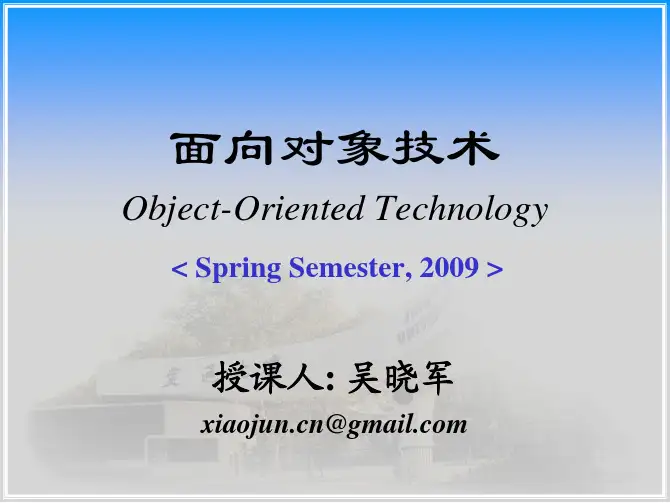
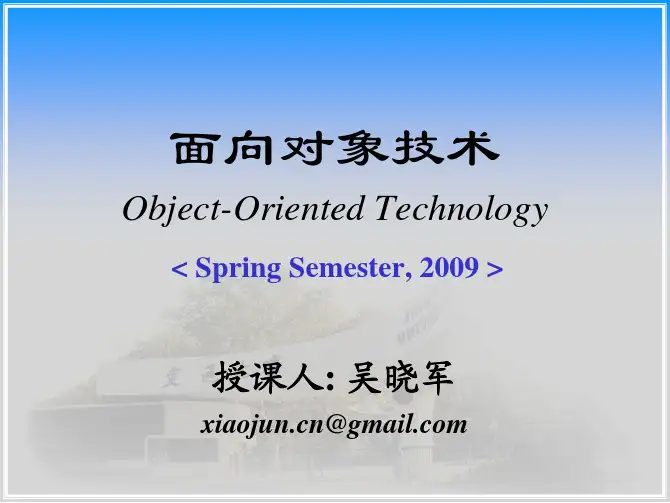
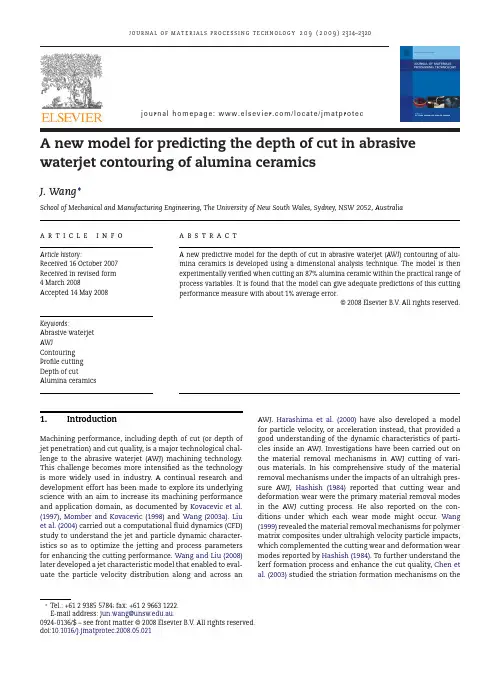
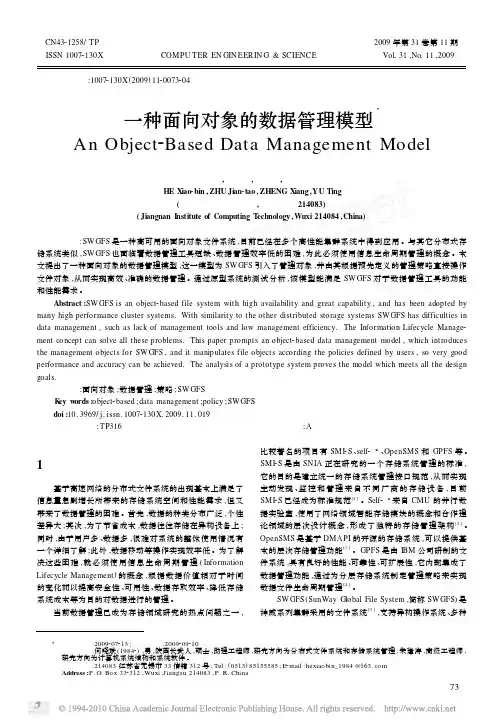
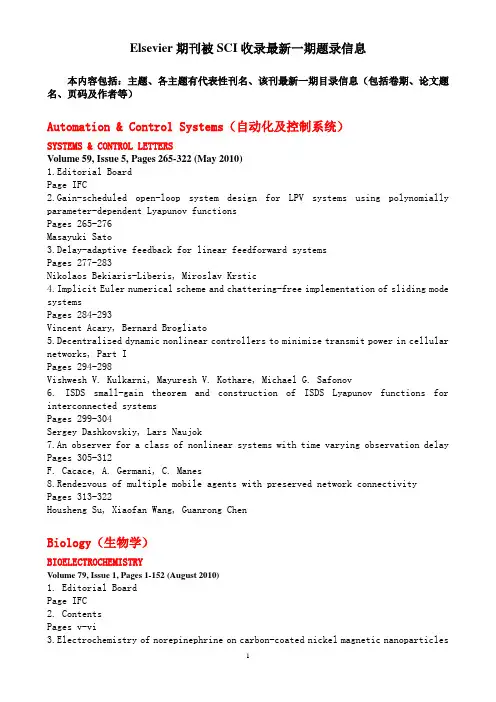
Elsevier期刊被SCI收录最新一期题录信息本内容包括:主题、各主题有代表性刊名、该刊最新一期目录信息(包括卷期、论文题名、页码及作者等)Automation & Control Systems(自动化及控制系统)SYSTEMS & CONTROL LETTERSVolume 59, Issue 5, Pages 265-322 (May 2010)1.Editorial BoardPage IFC2.Gain-scheduled open-loop system design for LPV systems using polynomially parameter-dependent Lyapunov functionsPages 265-276Masayuki Sato3.Delay-adaptive feedback for linear feedforward systemsPages 277-283Nikolaos Bekiaris-Liberis, Miroslav Krstic4.Implicit Euler numerical scheme and chattering-free implementation of sliding mode systemsPages 284-293Vincent Acary, Bernard Brogliato5.Decentralized dynamic nonlinear controllers to minimize transmit power in cellular networks, Part IPages 294-298Vishwesh V. Kulkarni, Mayuresh V. Kothare, Michael G. Safonov6. ISDS small-gain theorem and construction of ISDS Lyapunov functions for interconnected systemsPages 299-304Sergey Dashkovskiy, Lars Naujok7.An observer for a class of nonlinear systems with time varying observation delay Pages 305-312F. Cacace, A. Germani, C. Manes8.Rendezvous of multiple mobile agents with preserved network connectivity Pages 313-322Housheng Su, Xiaofan Wang, Guanrong ChenBiology(生物学)BIOELECTROCHEMISTRYVolume 79, Issue 1, Pages 1-152 (August 2010)1. Editorial BoardPage IFC2. ContentsPages v-vi3.Electrochemistry of norepinephrine on carbon-coated nickel magnetic nanoparticlesmodified electrode and analytical applicationsPages 1-5Chunli Bian, Qingxiang Zeng, Huayu Xiong, Xiuhua Zhang, Shengfu Wang4.Interaction of surface-attached haemoglobin with hydrophobic anions monitored by on-line acoustic wave detectorPages 6-10Jonathan S. Ellis, Steven Q. Xu, Xiaomeng Wang, Grégoi re Herzog, Damien W.M. Arrigan, Michael Thompson5.Electrochemical impedance spectroscopy of polypyrrole based electrochemical immunosensorPages 11-16A. Ramanavicius, A. Finkelsteinas, H. Cesiulis, A. Ramanaviciene6.Electrochemical and AFM characterization on gold and carbon electrodes of a high redox potential laccase from Fusarium proliferatumPages 17-24K. González Arzola, Y. Gimeno, M.C. Arévalo, M.A. Falcón, A. Hernández Creus7.Improvements in the extraction of cell electric properties from their electrorotation spectrumPages 25-30Damien Voyer, Marie Frénéa-Robin, Franois Buret, Laurent Nicolas8.Electrochemical DNA biosensor for the detection of specific gene related to Trichoderma harzianum speciesPages 31-36Shafiquzzaman Siddiquee, Nor Azah Yusof, Abu Bakar Salleh, Fatimah Abu Bakar, Lee Yook Heng9.Development of electrochemical DNA biosensor based on gold nanoparticle modified electrode by electroless depositionPages 37-42Shufeng Liu, Jing Liu, Li Wang, Feng Zhao10.Herbicides affect fluorescence and electron transfer activity of spinach chloroplasts, thylakoid membranes and isolated Photosystem IIPages 43-49Andrea Ventrella, Lucia Catucci, Angela Agostiano11.Nanostructured polypyrrole-coated anode for sun-powered microbial fuel cells Pages 50-56Yongjin Zou, John Pisciotta, Ilia V. Baskakov12.Anodic oxidation of 3,4-dihydroxyphenylacetic acid on carbon electrodes in acetic acid solutionsPages 57-65Slawomir Michalkiewicz, Agata Skorupa13.A voltammetric Rhodotorula mucilaginosa modified microbial biosensor for Cu(II) determinationPages 66-70Meral Yüce, Hasan Nazır, Gönül Dönmez14.Explore various co-substrates for simultaneous electricity generation and Congo red degradation in air-cathode single-chamber microbial fuel cellPages 71-76Yunqing Cao, Yongyou Hu, Jian Sun, Bin Hou15.Electrochemical oxidation of amphetamine-like drugs and application to electroanalysis of ecstasy in human serumPages 77-83E.M.P.J. Garrido, J.M.P.J. Garrido, N. Milhazes,F. Borges, A.M. Oliveira-Brett16.A l-cysteine sensor based on Pt nanoparticles/poly(o-aminophenol) film on glassy carbon electrodePages 84-89Li-Ping Liu, Zhao-Jing Yin, Zhou-Sheng Yang17.The effects of the electro-photodynamic in vitro treatment on human lung adenocarcinoma cellsPages 90-94Jolanta Saczko, Mariola Nowak, Nina Skolucka, Julita Kulbacka, Malgorzata Kotulska 18.Gadolinium blocks membrane permeabilization induced by nanosecond electric pulses and reduces cell deathPages 95-100Franck M. André, Mikhail A. Rassokhin, Angela M. Bowman, Andrei G. Pakhomov19.Scanning electrochemical microscopy activity mapping of electrodes modified with laccase encapsulated in sol–gel processed matrixPages 101-107Wojciech Nogala, Katarzyna Szot, Malte Burchardt, Martin Jönsson-Niedziolka, Jerzy Rogalski, Gunther Wittstock, Marcin Opallo20.Maltose biosensing based on co-immobilization of α-glucosidase and pyranose oxidasePages 108-113Dilek Odaci, Azmi Telefoncu, Suna Timur21.Plasma membrane permeabilization by trains of ultrashort electric pulses Pages 114-121Bennett L. Ibey, Dustin G. Mixon, Jason A. Payne, Angela Bowman, Karl Sickendick, Gerald J. Wilmink, W. Patrick Roach, Andrei G. Pakhomov22.Effect of nano-topographical features of Ti/TiO2 electrode surface on cell response and electrochemical stability in artificial salivaPages 122-129I. Demetrescu, C. Pirvu, V. Mitran23.Efficiency of the delivery of small charged molecules into cells in vitro Pages 130-135M.S. Venslauskas, S. Šatkauskas, R. Rodaitė-Riševičienė24.Carbon nanotube-enhanced cell electropermeabilisationPages 136-141Vittoria Raffa, Gianni Ciofani, Orazio Vittorio, Virginia Pensabene, Alfred Cuschieri25.Dependence of catalytic activity and long-term stability of enzyme hydrogel films on curing timePages 142-146Joshua Lehr, Bryce E. Williamson, Frédéric Barrière, Alison J. Downard26.Enzymatic flow injection method for rapid determination of choline in urine with electrochemiluminescence detectionPages 147-151Jiye Jin, Masahiro Muroga, Fumiki Takahashi, Toshio NakamuraChemistry Applied(化学应用)CARBOHYDRATE POLYMERSVolume 81, Issue 4, Pages 751-970 (23 July 2010)1.Editorial BoardPage CO22.Adsorption separation of Ni(II) ions by dialdehyde o-phenylenediamine starch from aqueous solutionPages 751-757Ping Zhao, Jian Jiang, Feng-wei Zhang, Wen-feng Zhao, Jun-tao Liu, Rong Li3.Rheological and morphological characterization of the culture broth during exopolysaccharide production by Enterobacter sp.Pages 758-764Vítor D. Alves, Filomena Freitas, Cristiana A.V. Torres, Madalena Cruz, Rodol fo Marques, Christian Grandfils, M.P. Gonçalves, Rui Oliveira, Maria A.M. Reis4.Synthesis and evaluation of N-succinyl-chitosan nanoparticles toward local hydroxycamptothecin deliveryPages 765-768Zhenqing Hou, Jing Han, Chuanming Zhan, Chunxiao Zhou, Quan Hu, Qiqing Zhang5.Synthesis and application of new sizing and finishing additives based on carboxymethyl cellulosePages 769-774Z. El-Sayed Mohamed, A. Amr, Dierk Knittel, Eckhard Schollmeyer6.Synthesis and thermo-physical properties of chitosan/poly(dl-lactide-co-glycolide) composites prepared by thermally induced phase separationPages 775-783Santos Adriana Martel-Estrada, Carlos Alberto Martínez-Pérez, José Guadalupe Chacón-Nava, Perla Elvia García-Casillas, Imelda Olivas-Armendarizparison of the immunological activities of arabinoxylans from wheat bran with alkali and xylanase-aided extractionPages 784-789Sumei Zhou, Xiuzhen Liu, Yan Guo, Qiang Wang, Daiyin Peng, Li Cao8.Nano-in-micro alginate based hybrid particlesPages 790-798Abhijeet Joshi, R. Keerthiprasad, Rahul Dev Jayant, Rohit Srivastava9.The effects of reaction conditions on block copolymerization of chitosan and poly(ethylene glycol)Pages 799-804F. Ganji, M.J. Abdekhodaie10.Thermal behaviour and interactions of cassava starch filled with glycerolplasticized polyvinyl alcohol blendsPages 805-810W.A.W.A. Rahman, Lee Tin Sin, A.R. Rahmat, A.A. Samad11.Banana fibers and microfibrils as lignocellulosic reinforcements in polymer compositesPages 811-819Maha M. Ibrahim, Alain Dufresne, Waleed K. El-Zawawy, Foster A. Agblevor12.Variability of biomass chemical composition and rapid analysis using FT-NIR techniquesPages 820-829Lu Liu, X. Philip Ye, Alvin R. Womac, Shahab Sokhansanj13.TEMPO oxidation of gelatinized potato starch results in acid resistant blocks of glucuronic acid moietiesPages 830-838Ruud ter Haar, Johan W. Timmermans, Ted M. Slaghek, Francisca E.M. Van Dongen, HenkA. Schols, Harry Gruppen14.Development of films based on quinoa (Chenopodium quinoa, Willdenow) starch Pages 839-848Patricia C. Araujo-Farro, G. Podadera, Paulo J.A. Sobral, Florencia C. Menegalli 15.Polysaccharide determination in protein/polysaccharide mixtures for phase-diagram constructionPages 849-854Jacob K. Agbenorhevi, Vassilis Kontogiorgos16.Calorimetric and light scattering study of interactions and macromolecular properties of native and hydrophobically modified hyaluronanPages 855-863Martin Chytil, Sabina Strand, Bjørn E. Christensen, Miloslav Pekař17.Spray drying of nopal mucilage (Opuntia ficus-indica): Effects on powder properties and characterizationPages 864-870F.M. León-Martínez, L.L. Méndez-Lagunas, J. Rodríguez-Ramírez18.Preparation and evaluation of nanoparticles of gum cordia, an anionic polysaccharide for ophthalmic deliveryPages 871-877Monika Yadav, Munish Ahuja19.Functional modification of agarose: A facile synthesis of a fluorescent agarose–guanine derivativePages 878-884Mihir D. Oza, Ramavatar Meena, Kamalesh Prasad, P. Paul, A.K. Siddhanta20.Characterization of maize amylose-extender (ae) mutant starches. Part III: Structures and properties of the Naegeli dextrinsPages 885-891Hongxin Jiang, Sathaporn Srichuwong, Mark Campbell, Jay-lin Jane21.Multistage deacetylation of chitin: Kinetics studyPages 892-896N. Yaghobi, F. Hormozi22.Sulfated modification, characterization and structure–antioxidantrelationships of Artemisia sphaerocephala polysaccharidesPages 897-905Junlong Wang, Hongyun Guo, Ji Zhang, Xiaofang Wang, Baotang Zhao, Jian Yao, Yunpu Wang23.Magnetic chitosan/iron (II, III) oxide nanoparticles prepared by spray-drying Pages 906-910Hsin-Yi Huang, Yeong-Tarng Shieh, Chao-Ming Shih, Yawo-Kuo Twu24.Effect of adding a small amount of high molecular weight polyacrylamide on properties of oxidized cassava starchPages 911-918Yan Liu, Xu-chao Lv, Xiao Hu, Zhi-hua Shan, Pu-xin Zhu25.Preparation of nanofibrillar carbon from chitin nanofibersPages 919-924M. Nogi, F. Kurosaki, H. Yano, M. Takano26.Preparation and characterization of cellulose acetate–Fe2O3 composite nanofibrous materialsPages 925-930Costas Tsioptsias, Kyriaki G. Sakellariou, Ioannis Tsivintzelis, Lambrini Papadopoulou, Costas Panayiotou27.Synthesis, characteristic and antibacterial activity of N,N,N-trimethyl chitosan and its carboxymethyl derivativesPages 931-936Tao Xu, Meihua Xin, Mingchun Li, Huili Huang, Shengquan Zhou28.Fast compositional analysis of ramie using near-infrared spectroscopyPages 937-941Wei Jiang, Guangting Han, Yuanming Zhang, Mengmeng Wang29.Structure characterization of polysaccharide isolated from the fruiting bodies of Tricholoma matsutakePages 942-947Xiang Ding, Su Feng, Mei Cao, Mao-tao Li, Jie Tang, Chun-xiao Guo, Jie Zhang, Qun Sun, Zhi-rong Yang, Jian Zhao30.New insights into viscosity abnormality of sodium alginate aqueous solution Pages 948-952Dan Zhong, Xin Huang, Hu Yang, Rongshi Cheng31.Structural characterization and anti-inflammatory activity of two water-soluble polysaccharides from Bellamya purificataPages 953-960Hong Zhang, Lin Ye, Kuiwu WangComputer Science, Artificial Intelligence(计算机科学,人工智能)ARTIFICIAL INTELLIGENCEVolume 174, Issue 11, Pages 639-766 (July 2010)1.Editorial BoardPage IFC2.Partial observability and learnabilityPages 639-669Loizos Michael3.Monte Carlo tree search in KriegspielPages 670-684Paolo Ciancarini, Gian Piero Favini4.Learning conditional preference networksPages 685-703Frédéric Koriche, Bruno Zanuttini5.Planning to see: A hierarchical approach to planning visual actions on a robot using POMDPsPages 704-725Mohan Sridharan, Jeremy Wyatt, Richard Dearden6.Analysis of a probabilistic model of redundancy in unsupervised information extractionPages 726-748Doug Downey, Oren Etzioni, Stephen Soderland7. Designing competitions between teams of individualsPages 749-766Pingzhong Tang, Yoav Shoham, Fangzhen LinEnergy & Fuels(能源和燃料)APPLIED ENERGYVolume 87, Issue 8, Pages 2427-2768 (August 2010)1.IFCPage IFC2. Energy balance analysis of wind-based pumped hydro storage systems in remote island electrical networksPages 2427-2437J.K. Kaldellis, M. Kapsali, K.A. Kavadias3.Energy auditing and energy conservation potential for glass worksPages 2438-2446Yingjian Li, Jiezhi Li, Qi Qiu, Yafei Xu4.Energy demand and comparison of current defrosting technologies of frozen raw materials in defrosting tunnelsPages 2447-2454Marek Bezovsky, Michal Stricik, Maria Prascakova5.Guidelines for clockspeed acceleration in the US natural gas transmission industry Pages 2455-2466Ruud Weijermars6.Multi-objective self-adaptive algorithm for highly constrained problems: Novel method and applicationsPages 2467-2478Abdelaziz Hammache, Marzouk Benali, François Aubé7.Stochastic interest rates in the analysis of energy investments: Implications on economic performance and sustainabilityPages 2479-2490Athanasios Tolis, Aggelos Doukelis, Ilias Tatsiopoulos8.Effects of the PWM carrier signals synchronization on the DC-link current in back-to-back convertersPages 2491-2499L.G. González, G. Garcerá, E. Figueres, R. González9.Efficiency improvement of the DSSCs by building the carbon black as bridge in photoelectrodePages 2500-2505Chen-Ching Ting, Wei-Shi Chao10.Integer programming with random-boundary intervals for planning municipal power systemsPages 2506-2516M.F. Cao, G.H. Huang, Q.G. Lin11. Modeling the relationship between the oil price and global food prices Pages 2517-2525Sheng-Tung Chen, Hsiao-I Kuo, Chi-Chung Chen12.Marginal production in the Gulf of Mexico – II. Model resultsPages 2526-2534Mark J. Kaiser, Yunke Yu13.Marginal production in the Gulf of Mexico – I. Historical statistics & model frameworkPages 2535-2550Mark J. Kaiser14.Assessment of forest biomass for use as energy. GIS-based analysis of geographical availability and locations of wood-fired power plants in PortugalPages 2551-2560H. Viana, Warren B. Cohen, D. Lopes, J. Aranha15.Alkaline catalyzed biodiesel production from moringa oleifera oil with optimized production parametersPages 2561-2565G. Kafuku, M. Mbarawae of two-component Weibull mixtures in the analysis of wind speed in the Eastern MediterraneanPages 2566-2573S.A. Akdağ, H.S. Bagiorgas, G. Mihalakakou17.Evaluation of wind energy investment interest and electricity generation cost analysis for TurkeyPages 2574-2580Seyit Ahmet Akdağ, Önder Güler18.The role of demand-side management in the grid integration of wind power Pages 2581-2588Pedro S. Moura, Aníbal T. de Almeida19.Synthesis of biodiesel from waste vegetable oil with large amounts of free fatty acids using a carbon-based solid acid catalystPages 2589-2596Qing Shu, Jixian Gao, Zeeshan Nawaz, Yuhui Liao, Dezheng Wang, Jinfu Wang20.A study on the overall efficiency of direct methanol fuel cell by methanol crossover currentPages 2597-2604Sang Hern Seo, Chang Sik Lee21.Study of heat transfer between an over-bed oil burner flame and a fluidized bed during start-up: Determination of the flame to bed convection coefficientPages 2605-2614Vijay Jain, Dominic Groulx, Prabir Basu22.Predictive tools for the estimation of downcomer velocity and vapor capacity factor in fractionatorsPages 2615-2620Alireza Bahadori, Hari B. Vuthaluru23. Monitoring strategies for a combined cycle electric power generatorPages 2621-2627Joshua Finn, John Wagner, Hany Bassily24. Combustion and heat transfer at meso-scale with thermal recuperationPages 2628-2639V. Vijayan, A.K. Gupta25.Part-load characteristics of direct injection spark ignition engine using exhaust gas trapPages 2640-2646Yun-long Bai, Zhi Wang, Jian-xin Wang26.Gas–liquid absorption reaction between (NH4)2SO3 solution and SO2 for ammonia-based wet flue gas desulfurizationPages 2647-2651Xiang Gao, Honglei Ding, Zhen Du, Zuliang Wu, Mengxiang Fang, Zhongyang Luo, Kefa Cen27. Direct contact PCM–water cold storagePages 2652-2659Viktoria Martin, Bo He, Fredrik Setterwall28. Fatty acid eutectic/polymethyl methacrylate composite as form-stable phase change material for thermal energy storagePages 2660-2665Lijiu Wang, Duo Meng29.Thermal characteristics of shape-stabilized phase change material wallboard with periodical outside temperature wavesPages 2666-2672Guobing Zhou, Yongping Yang, Xin Wang, Jinming Cheng30. Study on a compact silica gel–water adsorption chiller without vacuum valves: Design and experimental studyPages 2673-2681C.J. Chen, R.Z. Wang, Z.Z. Xia, J.K. Kiplagat, Z.S. Lu31. Separation characteristics of clathrate hydrates from a cooling plate forefficient cold energy storagePages 2682-2689Tadafumi Daitoku, Yoshio Utaka32. A flexible numerical model to study an active magnetic refrigerator for near room temperature applicationsPages 2690-2698Ciro Aprea, Angelo Maiorino33. Feasibility study of an ice slurry-cooling coil for HVAC and R systems in a tropical buildingPages 2699-2711Y.H. Yau, S.K. Lee34. Optimum sizing of wind-battery systems incorporating resource uncertainty Pages 2712-2727Anindita Roy, Shireesh B. Kedare, Santanu Bandyopadhyay35. Peak current mode control of three-phase boost rectifiers in discontinuous conduction mode for small wind power generatorsPages 2728-2736O. Carranza, G. Garcerá, E. Figueres, L.G. González36. Experimental flow field characteristics of OFA for large-angle counter flow of fuel-rich jet combustion technologyPages 2737-2745Weidong Fan, Zhengchun Lin, Youyi Li, Mingchuan ZhangEngineering, Electrical & Electronic(电机及电子工程)MICROELECTRONIC ENGINEERINGVolume 87, Issue 9, Pages 1655-1808 (November 2010)1. Inside Front Cover - Editorial BoardPage IFC2 PrefacePage 1655Joel Barnett3.In0.53Ga0.47As(1 0 0) native oxide removal by liquid and gas phase HF/H2O chemistriesPages 1656-1660F.L. Lie, W. Rachmady, A.J. Muscat4.A study of the interaction of gallium arsenide with wet chemical formulations using thermodynamic calculations and spectroscopic ellipsometryPages 1661-1664J. Price, J. Barnett, S. Raghavan, M. Keswani, R. Govindarajan5.The removal of nanoparticles from sub-micron trenches using megasonicsPages 1665-1668Pegah Karimi, Taehoon Kim, Juan Aceros, Jingoo Park, Ahmed A. Busnaina6.In-line control of Si loss after post ion implantation stripPages 1669-1673D. Shamiryan, D. Radisic, W. Boullart7.Removal of post-etch 193 nm photoresist in porous low-k dielectric patterning using UV irradiation and ozonated waterPages 1674-1679E. Kesters, Q.T. Le, M. Lux, L. Prager, G. Vereecke8.Repair of plasma-damaged p-SiOCH dielectric films in supercritical CO2Pages 1680-1684Jae Mok Jung, Hong Seok Kwon, Won-Ki Lee, Byung-Chun Choi, Hyun Gyu Kim, Kwon Taek Lim9.Development of compatible wet-clean stripper for integration of CoWP metal cap in Cu/low-k interconnectsPages 1685-1688Aiping Wu, Eugene Baryschpolec, Madhukar Rao, Matthias Schaller, Christin Bartsch, Susanne Leppack, Andreas Ott10.Dissolution and electrochemical impedance spectroscopy studies of thin copper oxide films on copper in semi-aqueous fluoride solutionsPages 1689-1695N. Venkataraman, S. Raghavan11.The sacrificial oxide etching of poly-Si cantilevers having high aspect ratios using supercritical CO2Pages 1696-1700Ha Soo Hwang, Jae Hyun Bae, Jae Mok Jung, Kwon Taek Lim12.Monitoring wafer cleanliness and metal contamination via VPD ICP-MS: Case studies for next generation requirementsPages 1701-1705Meredith Beebe, Scott Anderson13.Fabrication of a two-step Ni stamp for blind via hole application on PWB Pages 1707-1710In-Soo Park, Jin-Soo Kim, Seong-Hun Na, Seung-Kyu Lim, Young-Soo Oh, Su-Jeong Suh 14.Arrays of metallic nanocones fabricated by UV-nanoimprint lithographyPages 1711-1715Juha M. Kontio, Janne Simonen, Juha Tommila, Markus Pessa15.Synthesis, characterization of CeO2@SiO2 nanoparticles and their oxide CMP behaviorPages 1716-1720Xiaobing Zhao, Renwei Long, Yang Chen, Zhigang Chen16.Development of a triangular-plate MEMS tunable capacitor with linear capacitance–voltage responsePages 1721-1727M. Shavezipur, S.M. Hashemi, P. Nieva, A. Khajepour17.The correlation of the electrical properties with electron irradiation and constant voltage stress for MIS devices based on high-k double layer (HfTiSiO:N and HfTiO:N) dielectricsPages 1728-1734V. Mikhelashvili, P. Thangadurai, W.D. Kaplan, G. Eisenstein18. Intra-level voltage ramping-up to dielectric breakdown failure on Cu/porous low-k interconnections in 45 nm ULSI generationPages 1735-1740C.H. Huang, N.F. Wang, Y.Z. Tsai, C.I. Hung, M.P. Houng19. Anodic bonding of glass–ceramics to stainless steel coated with intermediate SiO2 layerPages 1741-1746Dehua Xiong, Jinshu Cheng, Hong Li, Wei Deng, Kai Ye20.Preparation of silica/ceria nano composite abrasive and its CMP behavior on hard disk substratePages 1747-1750Hong Lei, Fengling Chu, Baoqi Xiao, Xifu Tu, Hua Xu, Haineng Qiu21.Investigation on the controllable growth of monodisperse silica colloid abrasives for the chemical mechanical polishing applicationPages 1751-1755XiaoKai Hu, Zhitang Song, Haibo Wang, Weili Liu, Zefang Zhang22.Fabrication and electrical characteristics of ultrathin (HfO2)x(SiO2)1−x films by surface sol–gel method and reaction-anneal treatmentPages 1756-1759You-Pin Gong, Ai-Dong Li, Chao Zhao, Yi-Dong Xia, Di Wu23.Frequency properties of on-die power distribution network in VLSI circuits Pages 1760-1763Pavel Livshits, Yefim Fefer, Anton Rozen, Yoram Shapira24.Analytical modelling for the current–voltage characteristics of undoped or lightly-doped symmetric double-gate MOSFETsPages 1764-1768A. Tsormpatzoglou, D.H. Tassis, C.A. Dimitriadis, G. Ghibaudo, G. Pananakakis, N. Collaert25.Anti-buckling S-shaped vertical microprobes with branch springsPages 1769-1776Jung Yup Kim, Hak Joo Lee, Young-Ho Cho26.Characterization of UV photodetectors with MgxZn1−xO thin filmsPages 1777-1780Tung-Te Chu, Huilin Jiang, Liang-Wen Ji, Te-Hua Fang, Wei-Shun Shi, Tian-Long Chang, Teen-Hang Meen, Jingchang Zhong27.Barrier height temperature coefficient in ideal Ti/n-GaAs Schottky contacts Pages 1781-1784T. Göksu, N. Yıldırım, H. Korkut, A.F. Özdemir, A. Turut, A. Kökçe28.Optical coherence tomography for non-destructive investigation of silicon integrated-circuitsPages 1785-1791K.A. Serrels, M.K. Renner, D.T. Reid29.Materials selection procedure for RF-MEMSPages 1792-1795G. Guisbiers, E. Herth, B. Legrand, N. Rolland, T. Lasri, L. BuchaillotPreview PDF (303 K) | Related Articles30.Automated optical method for ultrasonic bond pull force estimationPages 1796-1804Henri Seppänen, Robert Schäfer, Ivan Kassamakov, Peter Hauptmann, Edward Hæggström31.Oxygen incorporation in TiN for metal gate work function tuning with a replacement gate integration approachPages 1805-1807Zilan Li, Tom Schram, Thomas Witters, Joshua Tseng, Stefan De Gendt, Kristin De MeyerEngineering, Industrial(工业工程)APPLIED ERGONOMICSVolume 41, Issue 5, Pages 643-718 (September 2010)1.Editorial BoardPage IFC2.Editorial for special issue of applied ergonomics on patient safetyPages 643-644Pascale Carayon, Peter Buckle3.Systems mapping workshops and their role in understanding medication errors in healthcarePages 645-656P. Buckle, P.J. Clarkson, R. Coleman, J. Bound, J. Ward, J. Brown4.Human factors in patient safety as an innovationPages 657-665Pascale Carayon5.Space to care and treat safely in acute hospitals: Recommendations from 1866 to 2008Pages 666-673Sue Hignett, Jun Lu6.Macroergonomics and patient safety: The impact of levels on theory, measurement, analysis and intervention in patient safety researchPages 674-681Ben-Tzion Karsh, Roger Brown7.Designing packaging to support the safe use of medicines at homePages 682-694James Ward, Peter Buckle, P. John Clarkson8.Reflective analysis of safety research in the hospital accident & emergency departmentsPages 695-700Robert L. Wears, Maria Woloshynowych, Ruth Brown, Charles A. Vincent9.Improving cardiac surgical care: A work systems approachPages 701-712Douglas A. Wiegmann, Ashley A. Eggman, Andrew W. ElBardissi, Sarah Henrickson Parker, Thoralf M. Sundt III10.Are hospitals becoming high reliability organizations?Pages 713-718Sebastiano Bagnara, Oronzo Parlangeli, Riccardo TartagliaEngineering, Civil(土木工程)ENGINEERING STRUCTURESVolume 32, Issue 7, Pages 1791-1956 (July 2010)1.A study of the collapse of a WWII communications antenna using numerical simulations based on design of experiments by FEMPages 1792-1800J.J. del Coz Díaz, P.J. García Nieto, A. Lozano Martínez-Luengas, J.L. Suárez Sierra 2.Evaluation study on structural fault of a Renaissance Italian palacePages 1801-1813Michele Betti, Gianni Bartoli, Maurizio Orlando3.Case study: Damage of an RC building after a landslide—inspection, analysis and retrofittingPages 1814-1820P. Tiago, E. Júlio4.Deep trench, landslide and effects on the foundations of a residential building:A case studyPages 1821-1829A. Brencich5.Forensic diagnosis of a shield tunnel failurePages 1830-1837Wei F. Lee, Kenji Ishihara6.Failure of concrete T-beam and box-girder highway bridges subjected to cyclic loading from trafficPages 1838-1845Kent K. Sasaki, Terry Paret, Juan C. Araiza, Peder Hals7.Durability problem of RC structures in Tuzla industrial zone — Two case studies Pages 1846-1860Radomir Folić, Damir Zenunović8.Transverse vibrations in existing railway bridges under resonant conditions: Single-track versus double-track configurationsPages 1861-1875M.D. Martínez-Rodrigo, J. Lavado, P. Museros9.Case study: Analytical investigation on the failure of a two-story RC building damaged during the 2007 Pisco-Chincha earthquakePages 1876-1887Oh-Sung Kwon, Eungsoo Kim10.An evaluation of effective design parameters on earthquake performance of RC buildings using neural networksPages 1888-1898M. Hakan Arslan11.Structural performance of the historic and modern buildings of the University of L’Aquila during the seismic events of April 2009Pages 1899-1924A.M. Ceci, A. Contento, L. Fanale, D. Galeota, V. Gattulli, M. Lepidi, F. Potenza14.Collapse modelling analysis of a precast soft storey building in Australia Pages 1925-1936。
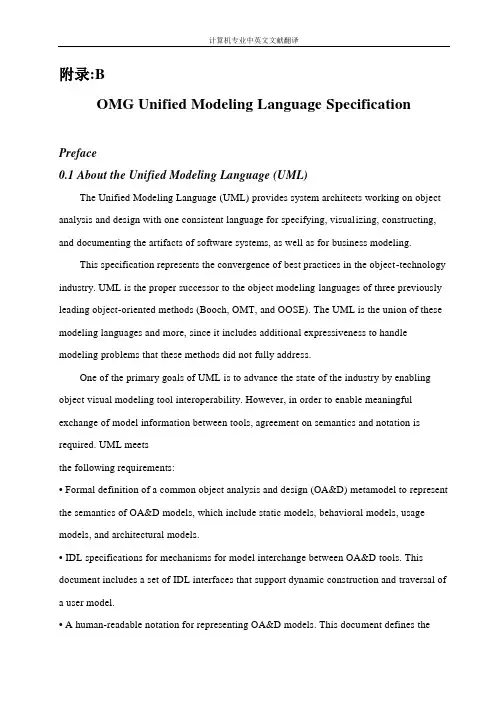
附录:BOMG Unified Modeling Language SpecificationPreface0.1 About the Unified Modeling Language (UML)The Unified Modeling Language (UML) provides system architects working on object analysis and design with one consistent language for specifying, visualizing, constructing, and documenting the artifacts of software systems, as well as for business modeling.This specification represents the convergence of best practices in the object-technology industry. UML is the proper successor to the object modeling languages of three previously leading object-oriented methods (Booch, OMT, and OOSE). The UML is the union of these modeling languages and more, since it includes additional expressiveness to handle modeling problems that these methods did not fully address.One of the primary goals of UML is to advance the state of the industry by enabling object visual modeling tool interoperability. However, in order to enable meaningful exchange of model information between tools, agreement on semantics and notation is required. UML meetsthe following requirements:• Formal definition of a common object analysis and design (OA&D) metamodel to represent the semantics of OA&D models, which include static models, behavioral models, usage models, and architectural models.•IDL specifications for mechanisms for model interchange between OA&D tools. This document includes a set of IDL interfaces that support dynamic construction and traversal of a user model.• A human-readable notation for representing OA&D models. This document defines theUML notation, an elegant graphic syntax for consistently expressing the UML’s rich semantics. Notation is an essential part of OA&D modeling and the UML.0.2 About the Object Management Group (OMG)The Object Management Group, Inc. (OMG) is an international organization supported by over 800 members, including information system vendors, software developers and users. Founded in 1989, the OMG promotes the theory and practice of object-oriented technology in software development. The organization's charter includes the establishment of industry guidelines and object management specifications to provide a common framework for application development. Primary goals are the reusability, portability, and interoperability of object-based software in distributed, heterogeneous environments. Conformance to these specifications will make it possible to develop a heterogeneous applications environment across all major hardware platforms and operating systems.OMG's objectives are to foster the growth of object technology and influence its direction by establishing the Object Management Architecture (OMA). The OMA provides the conceptual infrastructure upon which all OMG specifications are based.Contact the Object Management Group, Inc. at:OMG Headquarters492 Old Connecticut PathFramingham, MA 01701USATel: +1-508-820 4300Fax: +1-508-820 4303pubs@OMG’s adoption of the UML specification reduces the degree of confusion within the industry surrounding modeling languages. It settles unproductive arguments about methodnotations and model interchange mechanisms and allows the industry to focus on higher leverage, more productive activities. Additionally, it enables semantic interchange between visual modeling tools.0.3 About This DocumentThis document is intended primarily as a precise and self-consistent definition of the UML’s semantics and notation. The primary audience of this document consists of the Object Management Group, standards organizations, book authors, trainers, and tool builders. The authors assume familiarity with object-oriented analysis and design methods. The document isnot written as an introductory text on building object models for complex systems, although itcould be used in conjunction with other materials or instruction. The document will become more approachable to a broader audience as additional books, training courses, and tools that apply to UML become available.The Unified Modeling Language specification defines compliance to the UML, covers the architectural alignment with other technologies, and is comprised of the following topics: UML Summary (Chapter 1) - provides an introduction to the UML, discussing motivation and history.UML Semantics (Chapter 2) - defines the semantics of the Unified Modeling Language. The UML is layered architecturally and organized by packages. Within each package, the model elements are defined in the following terms:UML Notation Guide (Chapter 3) - specifies the graphic syntax for expressing the semantics described by the UML metamodel. Consequently, the UML Notation Guide’s chapter should be read in conjunction with the UML Semantics chapter.UML Standard Profiles (Chapter 4) - defines the UML Profile for Software Development Processes and the UML Profile for Business Modeling.UML CORBAfacility Interface Definition (Chapter 5) - uses CORBA IDL to specify a repository that enables the creation, storage and manipulation of UML models.UML XMI DTD Specification (Chapter 6) - uses XML DTD to define a physical mechanism for interchanging UML models that conform to the UML metamodel.Object Constraint Language Specification (Chapter 7) - defines the Object Constraint Language (OCL) syntax, semantics, and grammar. All OCL features are described in terms of concepts defined in the UML Semantics.In addition, there is appendix of Standard Elements that defines standard stereotypes, constraints and tagged values for UML, and a glossary of terms.0.3.1 Dependencies Between ChaptersUML Semantics (Chapter 2) can stand on its own, relative to the others, with the exception of the OCL Specification. The semantics depends upon OCL for the specification of its wellformedness rules.The UML Notation Guide, UML CORBAfacility Interface Definition and UML XMIDTD Specification all depend on the UML Semantics. Specifying these as separate standards will permit their evolution in the most flexible way, even though they are not completely independent.The specifications in the UML Standard Profiles depend on both the notation and semantics chapters.1. Abstract syntax UML class diagrams are used to present the UML metamodel, its concepts (metaclasses), relationships, and constraints. Definitions of the concepts are included.2. Well-formedness rules The rules and constraints on valid models are defined. The rules are expressed in English prose and in a precise Object Constraint Language (OCL). OCL is a specification language that uses logic for specifying invariant properties of systems comprising sets and relationships between sets.3. Semantics The semantics of model usage are described in English prose.0.4 Compliance to the UMLThe UML and corresponding facility interface definition are comprehensive. However, these specifications are packaged so that subsets of the UML and facility can be implemented without breaking the integrity of the language. The UML Semantics is packaged as follows:This packaging shows the semantic dependencies between the UML model elements in the different packages. The IDL in the facility is packaged almost identically. The notation is also “packaged” along the lines of diagram type. Compliance of the UML is thus defined along the lines of semantics, notation, and IDL.Even if the compliance points are decomposed into more fundamental units, vendors implementing UML may choose not to fully implement this packaging of definitions, while still faithfully implementing some of the UML definitions. However, vendors who want to precisely declare their compliance to UML should refer to the precise language defined herein, and not loosely say they are “UML compliant.”0.4.1 Compliance to the UML SemanticsThe basic units of compliance are the packages defined in the UML metamodel. The full metamodel includes the corresponding semantic rigor defined in the UML Semanticschapter of this specification.The class diagram illustrates the package dependencies, which are also summarized in the table.Complying with a package requires complying with the prerequisite package.The semantics are defined in an implementation language-independent way. An implementation of the semantics, without consistent interface and implementation choices, does not guarantee tool interoperability. See the OA&D CORBAfacility Interface Definition (Chapter 5).In addition to the above packages, compliance to a given metamodel package must load or know about the predefined UML standard elements (i.e., values for all predefined stereotypes, tags, and constraints). These are defined throughout the semantics and notation documents and summarized in the UML Standard Elements appendix. The predefined constraint values must be enforced consistent with their definitions. Having tools know about the standard elements is necessary for the full language and to avoid the definition of user-defined elements that conflict with the standard UML elements. Compliance to theUML Standard Elements and UML Standard Profiles is distinct from the UML Semantics, so not all tools need to know about the UML Standard Elements and UML Standard Profiles.For any implementation of UML, it is optional that the tool implements the Object Constraint Language. A vendor conforming to OCL support must support the following: • Validate and store syntactically correct OCL expressions as values for UML data types. • Be able to perform a full type check on the object constraint expression. This check will test whether all features used in the expression are actually defined in the UML model and used correctly. All tools conforming to the UML semantics are expected to conform to the following aspects of the semantics:• abstract syntax (i.e., the concepts, valid relationships, and constraints expressed in the corresponding class diagrams),• well-formedness rules, and• semantics of model usage.However, vendors are expected to apply some discretion on how strictly thewell-formedness rules are enforced. Tools should be able to report on well-formedness violations, but not necessarily force all models to be well formed. Incomplete models are common during certain phases of the development lifecycle, so they should be permitted. See the OA&D CORBAfacility Interface Definition (Chapter 5 of this specification) for its treatment of well-formedness exception handling, as an example of a technique to report well-formedness violations.0.4.2 Compliance to the UML NotationThe UML notation is an essential element of the UML to enable communication between team members. Compliance to the notation is optional, but the semantics are not very meaningful without a consistent way of expressing them.Notation compliance is defined along the lines of the UML Diagrams types: use case, class, statechart, activity graph, sequence, collaboration, component, and deploymentdiagrams.If the notation is implemented, a tool must enforce the underlying semantics and maintain consistency between diagrams if the diagrams share the same underlying model. By this definition, a simple "drawing tool" cannot be compliant to the UML notation.There are many optional notation adornments. For example, a richly adorned class icon may include an embedded stereotype icon, a list of properties (tagged values and metamodel attributes), constraint expressions, attributes with visibilities indicated, and operations with full signatures. Complying with class diagram support implies the ability to support all of the associated adornments.Compliance to the notation in the UML Standard Profiles is described separately.0.4.3 Compliance to the UML Standard ProfilesVendors should specify whether they support each of the UML Standard Profiles or not.Compliance to a profile means knowledge and enforcement of the semantics and corresponding notation.0.4.4 Compliance to the UML CORBAfacility Interface DefinitionThe IDL modules defined in the UML CORBAfacility parallel the packages in the semantic metamodel. The exception to this is that DataTypes and Extension Mechanisms have been merged in with the core for the facility. Except for this, a CORBAfacility implementing the interface modules has the same compliance point options as described in “Compliance to the UML Semantics” listed above.0.4.5 Compliance to the UML XMI DTD SpecificationThe DTD defined in the UML XMI DTD Specification parallel the packages in the semantic metamodel. The exception to this is that DataTypes and Extension Mechanisms have been merged in with the core for the facility. Except for this, an implementation of the XMI DTD has the same compliance point options as described in “Compliance to the UML Semantics” listedabove.0.5 AcknowledgementsThe UML was crafted through the dedicated efforts of individuals and companies who find UML strategic to their future. This section acknowledges the efforts of these individuals who contributed to defining UML.UML Core TeamThe following persons were members of the core development team for the UML proposal or served on the UML Revision Task Force:Data Access Corporation: Tom DigreElectronic Data Systems Corporation: Cris Kobryn, Joaquin MillerEnea Data: Karin PalmkvistHewlett-Packard Company: Martin GrissIBM Corporation: Steve Brodsky, Steve Cook, Jos WarmerI-Logix: Eran Gery, David HarelICON Computing: Desmond D’SouzaIntelliCorp and James Martin & Co.: Conrad Bock, James OdellOAO Technology Solutions: Ed SeidewitzObjecTime Limited: John Hogg, Bran SelicOracle Corporation: Guus RamackersPLATINUM Technology Inc.: Dilhar DeSilvaRational Software: Grady Booch, Ed Eykholt, Ivar Jacobson, Gunnar Overgaard, Jim RumbaughSAP: Oliver WiegertSOFTEAM: Philippe DesfraySterling Software: John Cheesman, Keith ShortTaskon: Trygve ReenskaugUnisys Corporation: Sridhar Iyengar, GK KhalsaUML 1.1 Semantics Task ForceDuring the final submission phase, a team was formed to focus on improving the formality of the UML 1.0 semantics, as well as incorporating additional ideas from the partners. Under the leadership of Cris Kobryn, this team was very instrumental in reconciling diverse viewpoints into a consistent set of semantics, as expressed in the revised UML Semantics. Other members of this team were Dilhar DeSilva, Martin Griss, Sridhar Iyengar, Eran Gery, James Odell, Gunnar Overgaard, Karin Palmkvist, Guus Ramackers, Bran Selic, and Jos Warmer. Grady Booch, Ivar Jacobson, and Jim Rumbaugh also provided their expertise to the team.UML Revision Task ForceAfter the adoption of the UML 1.1 proposal by the OMG membership in November, 1997, the OMG chartered a revision task force (RTF) to deal with bugs, inconsistencies, and other problems that could be handled without greatly expanding the scope of the original proposal. The RTF accepted public comments submitted to the OMG after adoption of the proposal. This document containing UML version 1.3 is the result of the work of the UML RTF. The results have been issued in several preliminary versions with minor changes expected in the final version. If you have a preliminary version of the specification, you can obtain an updated version from the OMG web site at .Contributors and SupportersWe also acknowledge the contributions, influence, and support of the following individuals. Jim Amsden, Hernan Astudillo, Colin Atkinson, Dave Bernstein, Philip A. Bernstein, Michael Blaha, Mike Bradley, Ray Buhr, Gary Cernosek, James Cerrato, Michael Jesse Chonoles, Magnus Christerson, Dai Clegg, Peter Coad, Derek Coleman, Ward Cunningham, Raj Datta, Mike Devlin, Philippe Desfray, Bruce Douglass, Staffan Ehnebom, Maria Ericsson, Johannes Ernst, Don Firesmith, Martin Fowler, Adam Frankl, Eric Gamma,Dipayan Gangopadhyay, Garth Gullekson, Rick Hargrove, Tim Harrison, Richard Helm, Brian Henderson-Sellers, Michael Hirsch, Bob Hodges, Glenn Hollowell, Yves Holvoet, Jon Hopkins, John Hsia, Ralph Johnson, Stuart Kent, Anneke Kleppe, Philippe Kruchten, Paul Kyzivat, Martin Lang, Grant Larsen, Reed Letsinger, Mary Loomis, Jeff MacKay, Bev Macmaster, Robert Martin, Terrie McDaniel, Jim McGee, Bertrand Meyer, Mike Meier, Randy Messer, Greg Meyers, Fred Mol, Luis Montero, Paul Moskowitz, Andy Moss, Jan Pachl, Paul Patrick, Woody Pidcock, Bill Premerlani, Jeff Price, Jerri Pries, Terry Quatrani, Mats Rahm, George Reich, Rich Reitman, Rudolf M. Riess, Erick Rivas, Kenny Rubin, Bernhard Rumpe, Jim Rye, Danny Sabbah, Tom Schultz, Gregson Siu, Jeff Sutherland, Dan Tasker, Dave Tropeano, Andy Trice, Dan Uhlar, John Vlissides, Larry Wall, Paul Ward, Oliver Wiegert, Alan Wills, Rebecca Wirfs-Brock, Bryan Wood, Ed Yourdon, and Steve Zeigler.。

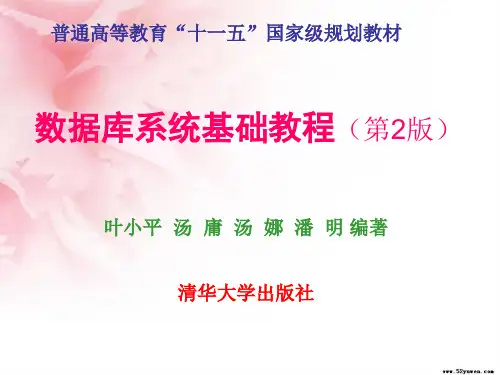

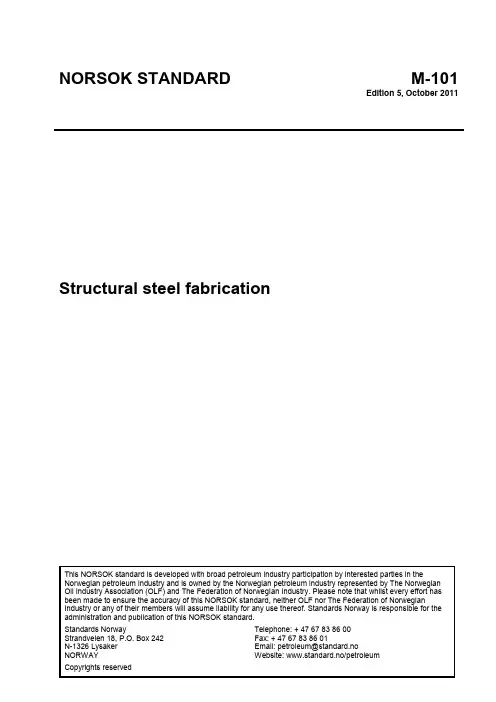
A Navigational Data Modelfor Object Modeling Technique (OMT) Development Environment
Jae-Dong Yang* Myung-Nam Bae* Jae-Woo Chang** Wan Choi + Joon-Kyung Lee+* Dept. of Computer Science, Chonbuk National University,Chonju, 560-756, Republic of Koreaemail: {jdyang, mnbae}@jbdblab.chonbuk.ac.kr
** Dept. of Computer Engineering, Chonbuk National University,Chonju, 560-756, Republic of Koreaemail: jwchang@moak.chonbuk.ac.kr
+ Electronics and Telecommunications Research Institute (ETRI)
161 Kajong-Dong, Yusong-Gu, Taejon, 305-350, Republic of Koreaemail: {wchoi, jklee}@nice.etri.re.kr
Keywords: Object Modeling Technique, Data Model, Navigation
ABSTRACT Extant tools supporting OMT(Object Modeling Technique) have a serious drawback that they fail to capture a lot ofrelationships inherently existing among design objects. This drawback may not only disallow designers to freely navigate therelationships but also make it difficult to automatically enforce integrity constraints derived from the relationships. To overcome thedrawback, we propose a navigational data model called FONASSE(FOur-dimensional NAvigation Spaceship for SoftwareEngineering). The data model captures four structural relationships among design objects : part of, the other development stage of,
the other representation of, and version of. A considerable part of structural semantics the design objects inherently have can be wellcaptured with the relationships. Since the four relationships are mutually exclusive with each other, designers may navigate a set ofdesign objects in a four-dimensional space. Supporting the relationships at system level also entails the automatic enforcement ofcorresponding integrity constraints. We identified four integrity constraints, each of which is derived from one of the fourrelationships. In this paper, FONASSE is fully developed as a model suitable to the four-dimensional navigation. As a first steptoward such development, a navigation function is defined to formally specify the semantics of queries related with the navigation.The queries, which turn out to be a specification of navigation paths, can be uniformly formulated by the combination of thenavigation functions. The integrity constraints corresponding to the relationships are also expressed in terms of the navigationfunctions. Finally, we provide a scenario to explain the navigational characteristic of our model.1. IntroductionFunction-oriented software development methodologies have been rapidly replaced by object-oriented ones [1, 7, 11]. Obviously, object-oriented (OO) technology seems to be the softwaredevelopment solution of the next century [12]. A major characteristic of the OO methodologies liesin its way of thinking about software to put emphasis on static data perspectives rather thandynamic functional ones [7, 19]. In the OO methodologies, programs are the models of applicationdomains, whereas in the function-oriented ones, they are the stream of actions that constitutesolutions to target problems [7]. In other words, the OO methodologies encourage softwaredevelopers to work and think in terms of the application domains to capture what is the problemrather than how the problem is solved. It is only when the inherent concepts of the application areidentified, organized, and understood that the details of data structures and functions can beaddressed effectively [19]. Rumbaugh proposed OMT (Object Modeling Technique) as one of the OO methodologies [19].This technology is characterized by its graphic notations to uniformly model applicationenvironments based on OO concepts during whole software development life cycle. This uniformityturns out to be an important advantage of OMT over other methodologies adopting the OO conceptsonly to analysis stage. That is because the uniformity makes it possible for one kind of design toolsto be applied consistently to the whole development life cycle. According to [15], the OMTmethodology is ranked as the most promising OO development methodology together with Booch'smethod. Currently many successful test cases of OMT have been reported [3, 5, 8, 9].To take full advantage of the OMT methodology, numerous OMT tools have been alsocustomized such as LOV/OMT[12], Paradigm Plus[18] and Rationale Rose [19]. Such OMT tools,however, have one significant drawback in treating design objects produced in the OMTdevelopment environment—they lack well-defined underlying data model. The consequence is thatthey fail to capture much of inter-relational semantics among the design objects including fourrelationships such as part of, the other development stage of, the other representation of andversion of. This drawback may make it difficult for designers to appropriately refer to relateddesign objects based on the four relationships. Furthermore, since the relationships are generic andhave structural semantics, it is quite probable that they are referenced repetitively, combined witheach other making specific patterns. For example, when a designer consults an object diagram of'ATM', it is quite probable that he may want to refer to the state diagram of one of its sub-components, say, Bank, followed by the program code of the state diagram. It is thereforenecessitated that the relationships be captured and dealt with at system level. To capture suchrelationships at system level may entail the automatic enforcement of corresponding integrityconstraints. For example, when a designer is trying to modify the signature part of a program code,